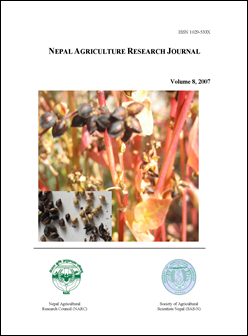Integrated Disease Management of Tomato Late Blight
DOI:
https://doi.org/10.3126/narj.v8i0.11583Keywords:
Dithane-M45, Krilaxyl, mugwort, Neem, Phytophthora infestans, TrichodermaAbstract
Tomato late blight caused by Phytophthora infestans (Mont.) de Bary is a serious disease of tomato and potato worldwide. The disease causes severe crop losses in the tomato growing regions of the world. Most of the cultivars grown in the world are reported to be susceptible to late blight. Systemic fungicides have been used widely in the past, but the disease has developed resistance over time. The present study was carried out to minimize fungicide use through integrated pest management. The bio-pesticides Azadirachta indica (Neem), Artemisia vulgaris (Mugwort) and Trichoderma viride were tested along with the fungicides Krilaxyl (metalaxyl 8% and mancozeb 64%) and Dithane M-45 (mancozeb 80%) in Nepal during 2000 and 2001. All three bio-pesticides were found more effective than the control in reducing development of the disease and they increased yield over the control by 17 to 41%. However, the fungicides, Krilaxyl and Dithane M-45 were observed even more effective. Two transplanting dates ie first and third week of July were tested against late blight in rainy season during 2000and 2001 and observed its effect on yields. Lower disease incidence and better yield were found in the second planting.
Nepal Agric. Res. J. Vol. 8, 2007, pp. 67-76
Downloads
Downloads
Published
How to Cite
Issue
Section
License
This license allows reusers to copy and distribute the material in any medium or format in unadapted form only, for noncommercial purposes only, and only so long as attribution is given to the creator.




